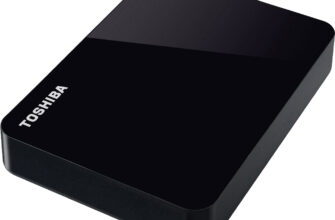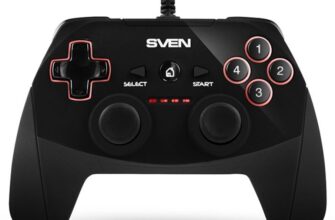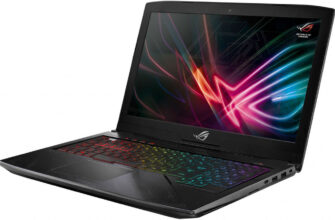Review of the best according to the editorial board. On the selection criteria. This material is subjective and does not constitute advertising and does not serve as a purchase guide. Before buying, you need to consult with a specialist.
Regarding the choice of a video card when completing a computer, the principle “the more powerful the better” has always been applied. Of course, if we are talking about a car with at least some gaming capabilities. All this is also relevant in 2019, adjusted for the volatility of the market for these devices, which was significantly influenced by cryptocurrency mining. The editors present you with a rating with an overview of powerful video cards of the mass segment as of early September. This does not include professional maps, as this is a separate topic.
- Rating of the most powerful video cards
- The most powerful video cards of the top segment
- GIGABYTE GeForce RTX 2080 Ti 1770MHz PCI-E 3.0 11264MB 14140MHz 352 bit
- Advantages
- disadvantages
- MSI GeForce RTX 2080 Ti 1350MHz PCI-E 3.0 11264MB 14000MHz 352 bit
- Advantages
- disadvantages
- ASUS GeForce RTX 2080 Ti 1350MHz PCI-E 3.0 11264MB 14000MHz 352 bit
- Advantages
- disadvantages
- Palit GeForce RTX 2080 1515MHz PCI-E 3.0 8192MB 14000MHz 256 bit
- Advantages
- disadvantages
- The most powerful mid-range graphics cards
- Sapphire Nitro + Radeon RX Vega 64 1373Mhz PCI-E 3.0 8192Mb 1890Mhz 2048 bit
- Advantages
- disadvantages
- GIGABYTE GeForce RTX 2060 SUPER 1815MHz PCI-E 3.0 8192MB 14000MHz 256 bit
- Advantages
- disadvantages
- ASRock Radeon RX 5700 1465MHz PCI-E 4.0 8192MB 14000MHz 256 bit
- Advantages
- disadvantages
- Sapphire Pulse Radeon RX 580 1366MHz PCI-E 3.0 4096MB 7000MHz 256 bit
- Advantages
- disadvantages
- The most powerful budget graphics cards
- Sapphire Pulse Radeon RX 550 1206Mhz PCI-E 3.0 2048Mb 7000Mhz 128 bit
- Advantages
- disadvantages
- ASUS Radeon RX 560 1149MHz PCI-E 3.0 2048MB 6000MHz 128 bit
- Advantages
- disadvantages
- GIGABYTE GeForce GT 1030 1252MHz PCI-E 3.0 2048MB 6008MHz 64 bit
- Advantages
- disadvantages
- MSI GeForce GT 730
- Advantages
- disadvantages
Rating of the most powerful video cards
| Nomination | a place | Name of product | price |
| The most powerful video cards of the top segment | 1 | GIGABYTE GeForce RTX 2080 Ti 1770MHz PCI-E 3.0 11264MB 14140MHz 352 bit | RUB 86,258 |
| 2 | MSI GeForce RTX 2080 Ti 1350MHz PCI-E 3.0 11264MB 14000MHz 352 bit | RUB 74,280 | |
| 3 | ASUS GeForce RTX 2080 Ti 1350MHz PCI-E 3.0 11264MB 14000MHz 352 bit | RUB 79,970 | |
| 4 | Palit GeForce RTX 2080 1515MHz PCI-E 3.0 8192MB 14000MHz 256 bit | RUB 47 873 | |
| The most powerful mid-range graphics cards | 1 | Sapphire Nitro + Radeon RX Vega 64 1373Mhz PCI-E 3.0 8192Mb 1890Mhz 2048 bit | 28 174 RUB |
| 2 | GIGABYTE GeForce RTX 2060 SUPER 1815MHz PCI-E 3.0 8192MB 14000MHz 256 bit | RUB 29 405 | |
| 3 | ASRock Radeon RX 5700 1465MHz PCI-E 4.0 8192MB 14000MHz 256 bit | RUB 21,148 | |
| 4 | Sapphire Pulse Radeon RX 580 1366MHz PCI-E 3.0 4096MB 7000MHz 256 bit | RUB 11,700 | |
| The most powerful graphics cards in the budget segment | 1 | Sapphire Pulse Radeon RX 550 1206Mhz PCI-E 3.0 2048Mb 7000Mhz 128 bit | RUB 5,660 |
| 2 | ASUS Radeon RX 560 1149MHz PCI-E 3.0 2048MB 6000MHz 128 bit | RUB 7 498 | |
| 3 | GIGABYTE GeForce GT 1030 1252MHz PCI-E 3.0 2048MB 6008MHz 64 bit | RUB 4 709 | |
| 4 | MSI GeForce GT 730 | RUB 3,478 |
The review was compiled using data from RankQuality.com and https://market.yandex.ru/.
The most powerful video cards of the top segment
First of all, we will consider a selection of four video cards, which, no doubt, can be considered top-end today. They are not the most expensive ones on the market, but they will satisfy the needs of comfortable gaming without problems. With watching videos in ultra-high definition, of course, there will be no problems either.
GIGABYTE GeForce RTX 2080 Ti 1770MHz PCI-E 3.0 11264MB 14140MHz 352 bit
Rating: 4.9
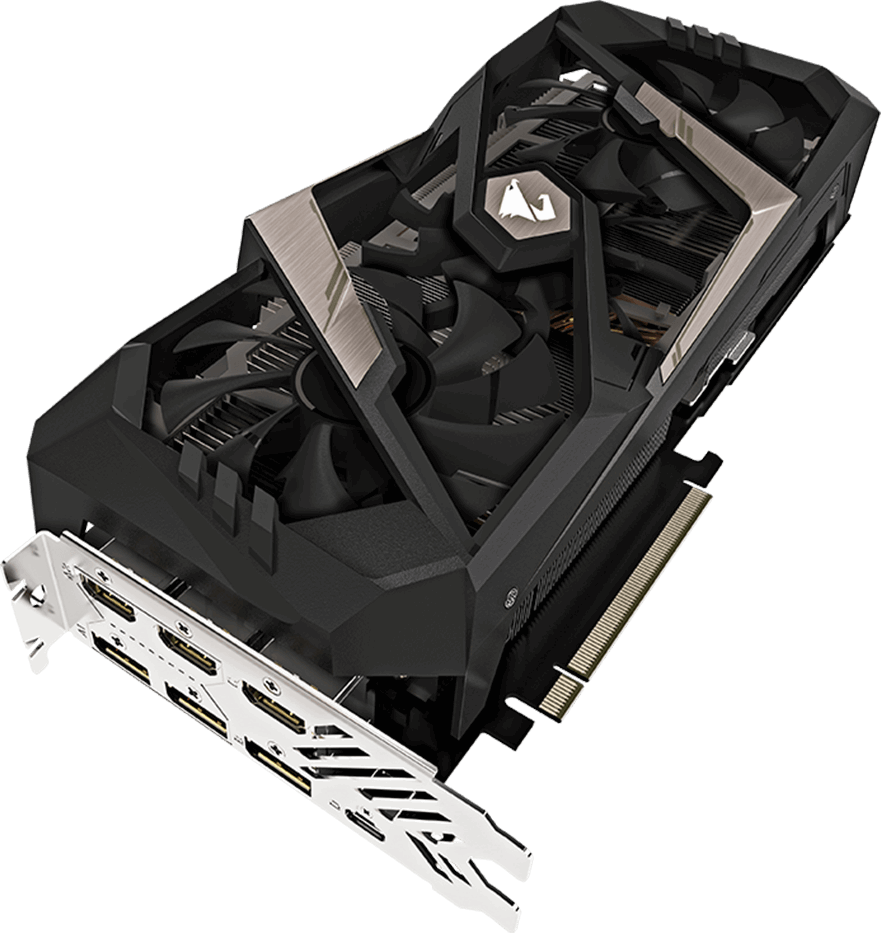
Let's start with the most expensive and powerful graphics card in the collection. This is a fairly large dual-slot device measuring 291x159x29mm and with a decent power consumption of 750W. To power this model, two 8-pin sockets are needed, and the water cooling system extinguishes the heat. Design details dominate the cooling system and look very impressive.
The central computing unit of the device is the NVIDIA GeForce RTX 2080Ti processor. A PCI-E 16x 3.0 connector is used to connect to the motherboard. The key electronics are manufactured using the 12nm process technology. Last but not least, this provides a record clock speed of 1770MHz. The device is equipped with the latest GDDR6 11264MB memory with a frequency of 14140 MHz. Compatible bus width for memory is 352 bits. NVLink supported.
All these impressive electronics provide outstanding capabilities. So, the video card supports up to 4 monitors, the maximum resolution is 7680×4320. Peripherals are connected via interfaces: three HDMI 2.0b, three DisplayPort 1.4, Type-C. Built-in HDCP data security technology is supported.
On the software side, this video card demonstrates the following: support for DirectX 12 and OpenGL 4.6 standards, CUDA technology version 7.1 and Vulkan, OpenCL version 2.0.
As for the mathematical core, the parameters here are: 6.1 version of shaders, 272 texture units, 88 rasterization units. All this is controlled by 4352 universal processors.
Information about the type of fittings can also be useful – here it is G1 / 4 “.
Advantages
- performance;
- moderate heating;
- water cooling;
- lends itself to overclocking;
- spectacular design.
disadvantages
- there are cases of characteristic whistle of chokes.
MSI GeForce RTX 2080 Ti 1350MHz PCI-E 3.0 11264MB 14000MHz 352 bit
Rating: 4.8
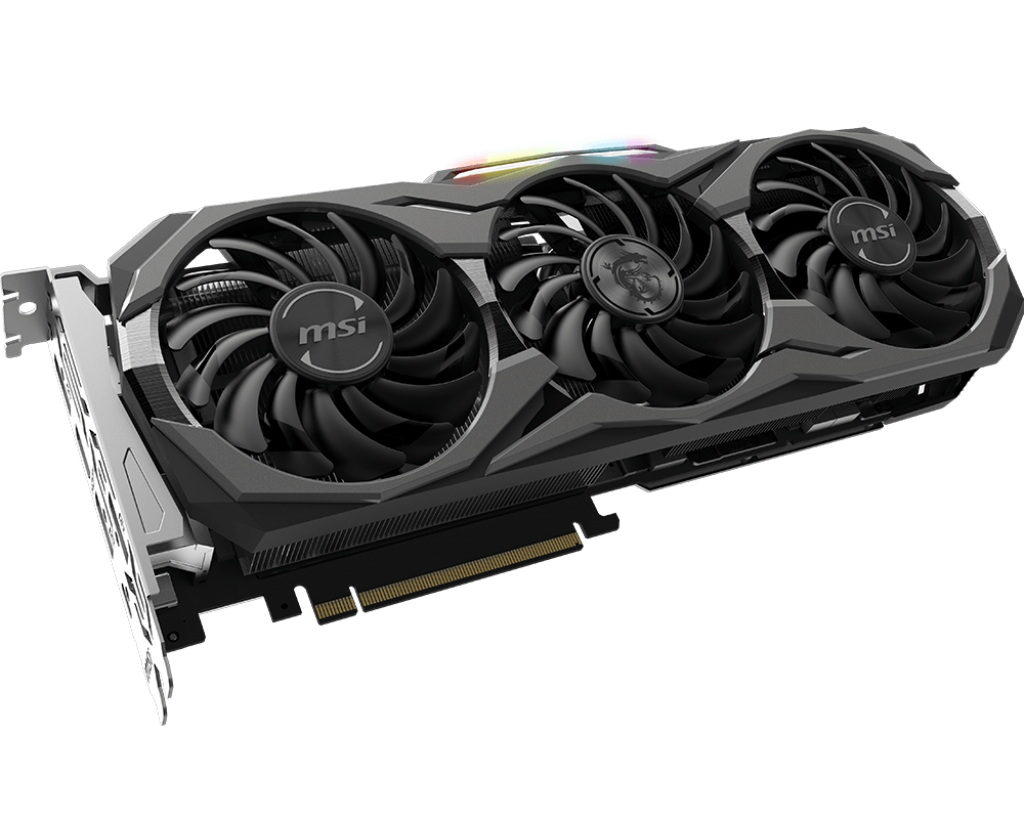
Continuing the nomination of powerful video cards in our rating is practically the sister of the previous model, but with slightly different characteristics and from another manufacturer – Taiwanese tech giant MSI.
The video card is slightly larger than the previous one – 327x140x56mm, occupies three slots. Powered by three sockets – two 8-pin and one 6-pin. It is recommended to install a 65-watt power supply when completing the PC. The custom cooling system comes with three fans and a pretty backlit design. The base interface is PCI-E 16x 3.0.
The heart of the system is the NVIDIA GeForce RTX 2080Ti graphics processor, built using the same subtle process technology as the 12nm model described above. Processor frequency – 1350MHz (in Boost mode you can overclock up to 1755 MHz. The card is equipped with GDDR6 RAM in the volume of 11264MB, operating at 14000MHz. Bus width – 352bit.
The technical parameters that are obvious to the user are the same as those of the model from GIGABYTE. This is a maximum resolution of 7680×4320, support for up to four monitors, ports – HDMI 2.0b, USB Type-C and three DisplayPort 1.4 sockets. There is also built-in support for HDCP, NVLink. Support for the OpenGL 4.6 and DirectX 12 standards has been implemented.
The mathematical core includes 4352 universal processors, 272 texture units, 6.1 version of shaders, 88 rasterization units, 7.1 version of CUDA.
Also, as in the previous version, there is support for Vulkan and OpenCL version 2.0.
Advantages
- performance;
- quiet and efficient cooling;
- equipment;
- simple overclocking;
- backlit appearance.
disadvantages
- overall and massive.
ASUS GeForce RTX 2080 Ti 1350MHz PCI-E 3.0 11264MB 14000MHz 352 bit
Rating: 4.7
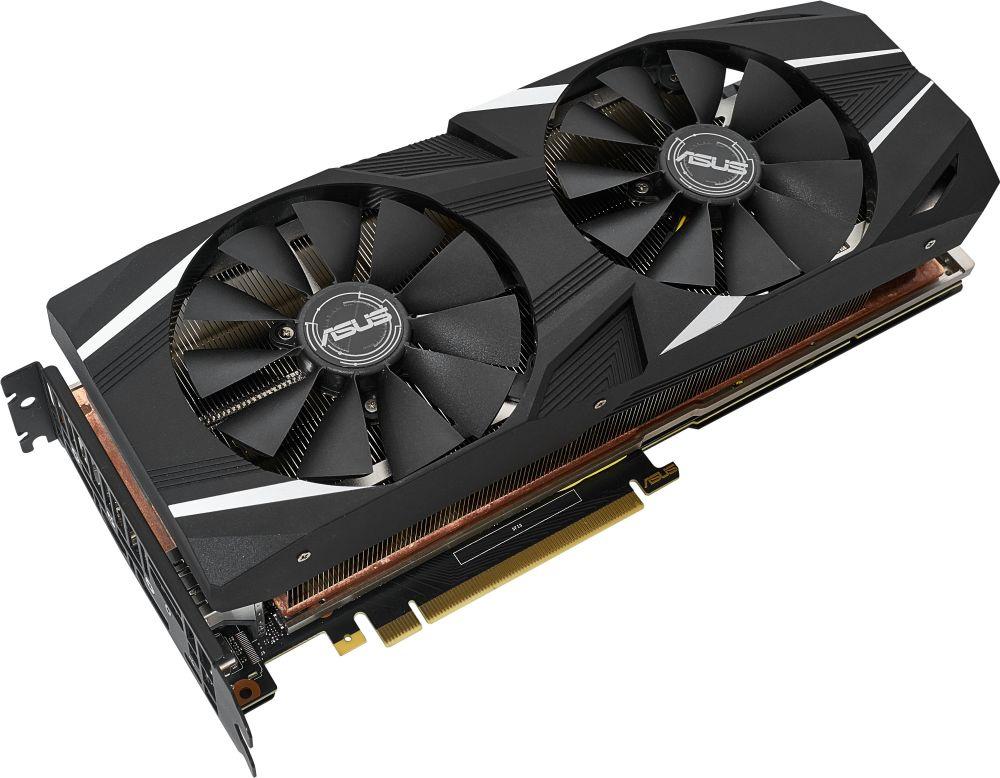
The third number in the ranking is another top-end 'twenty-eighty', but already manufactured by ASUS – especially for true fans of this brand. The main characteristics are almost the same here, with minor differences.
The dimensions of the video card are 268x114x58mm, designed for three slots. Powered by two 8-pin sockets. A 650W power supply is recommended. The custom cooling unit consists of two fans. In general, the design is austere, not too expressive, without clumsy. Connects via PCI-E 16x 3.0.
The device is equipped with a graphics core NVIDIA GeForce RTX 2080 Ti with a frequency of 1350MHz. Accelerates up to 1650 MHz depending on the mode (game or work in OS applications). Thin electronics are manufactured using a 12nm process technology.
The main features of the device are almost the same as those of the two previous video cards. This is GDDR6 memory in the volume of 11264MB at a frequency of 14000MHz with a bus width of 352bit. The card supports up to 4 monitors simultaneously, and is capable of displaying images in quality up to 7680×4320. Communication with peripherals via HDMI 2.0b, DisplayPort 1.4 (3 pcs.) USB Type-C.
Mathematical unit parameters: 272 texture units, 88 rasterization units, 6.1 version of shaders, 4352 universal processors.
Standards and technologies supported: NVLink, HDCP, DirectX 12, OpenGL 4.6, CUDA 7.1, Vulkan, OpenCL 2.0.
Advantages
- power and performance;
- lends itself to overclocking;
- reliability;
- relatively quiet;
- design.
disadvantages
- no noticeable flaws were found.
Palit GeForce RTX 2080 1515MHz PCI-E 3.0 8192MB 14000MHz 256 bit
Rating: 4.7

And at the end of the first part of the rating, we will pay attention to a somewhat unusual video card. And what is unusual about it is the cost. It is almost two times cheaper than all three predecessors, but at the same time it is certainly top-end, and it can handle modern toys without problems.
The dimensions of this video card are 292x130x60mm, designed for three slots. Two 8-pin connectors are used to connect the power supply. Recommended 650-watt power supply included with the case. Active cooling is provided by two fans, and I must say that their appearance in combination with other design elements of the card evokes respect for its impressiveness and, at the same time, 'airiness'. A video card is connected via PCI-E 16x 3.0.
It uses almost the same graphics processor as in the above models – GeForce RTX 2080 from NVIDIA, but with a slightly different frequency: nominal – 1515MHz, up to 1875MHz in overclocking. The electronics are all made according to the same delicate 12nm process technology.
Our readers, of course, are interested in why such a dramatic difference in price was achieved. And here it's all about memory. It provides 8192MB GDDR6 at a frequency of 14000MHz and the bus width is no longer so perfect – 256 bits. But these are actually the first and last major compromises in this model.
The ability to reproduce the resolution is the same here – 7680×4320, four monitors are supported. Interfaces: HDMI 2.0b, three DisplayPort 1.4 ports, USB Type-C. NVLink, DirectX 12, OpenGL 4.6, CUDA 7.1, Vulkan, OpenCL 1.2 are supported
Mathematical: 2944 universal processors, 6.1 version of shaders, 184 texture units, 64 rasterization units.
Advantages
- performance;
- stable and reliable work;
- build quality;
- attractive design;
- relatively affordable price.
disadvantages
- imperfections in software.
The most powerful mid-range graphics cards
The second nomination in the rating of powerful video cards according to the version presents a selection of graphics modules that, on the one hand, are able to cope with most tasks for working with graphics and modern gaming, and on the other hand, they will not make up the half-year budget of an average family for the price.
Sapphire Nitro + Radeon RX Vega 64 1373Mhz PCI-E 3.0 8192Mb 1890Mhz 2048 bit
Rating: 4.9
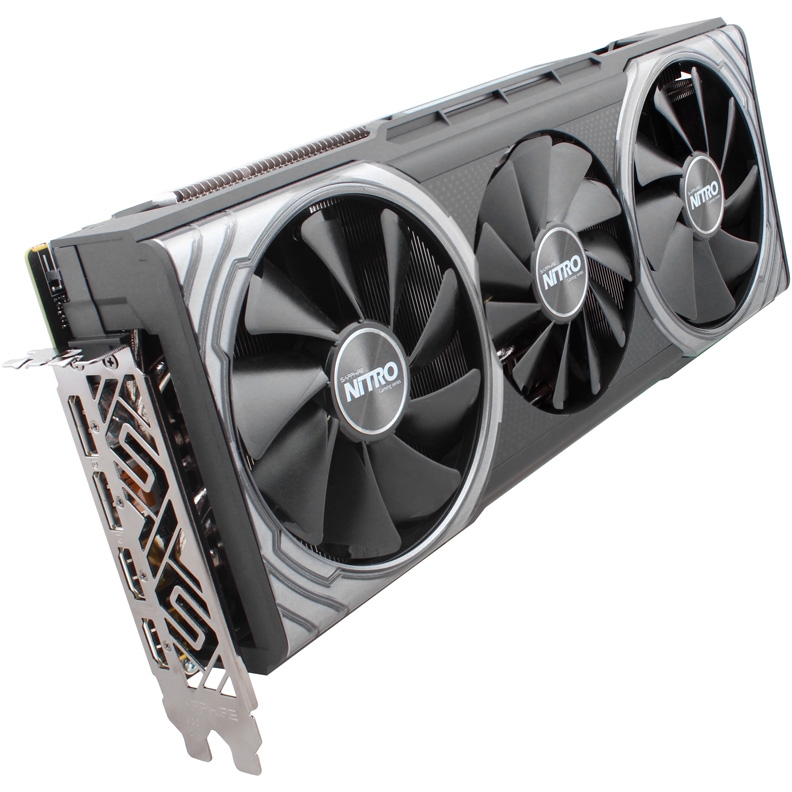
Let's start with the first 'Sapphire' in this collection, the improved Nitro. In terms of the most key characteristics, the card does not even lose much to the above-described Palit, but it is cheaper by a whole third (at least, it depends on the point of sale).
This device measures 310x133x54mm and is designed for three slots. Cooling system – three fans across the entire plane. The overall design is laconic but stylish. Powered by two 8-pin sockets. For optimal power supply, a 750W power supply is desirable in the system unit configuration. Connects to the motherboard via PCI-E 16x 3.0.
The center of the computing part of the video card is the original Radeon RX Vega 64 processor manufactured by AMD. Manufactured according to the 14nm process technology. Operates at 1373MHz (base) or 1580MHz in overclocking mode. The card is equipped with 8192MB HBM2 RAM with a frequency of 1890MHz and a bus width of 2048 bits.
All this equipment is capable of producing a 'picture' with a resolution of 7680×4320 with support for four monitors. For connecting peripherals, there are two HDMI 2.0b and DisplayPort 1.4 ports. There is support for SLI / CrossFire.
The math unit has the following characteristics: 5.0 version of shaders, 256 texture units, 16x anisotropic filtering, 64 rasterization units and 4096 universal processors.
The software part includes OpenGL 4.5, DirectX 12, OpenCL 2.0, Vulkan.
This video card is covered by an official 3-year warranty.
Advantages
- productive;
- lends itself to overclocking;
- exceptionally high quality cooling;
- quiet;
- stylish design.
disadvantages
- high power consumption.
GIGABYTE GeForce RTX 2060 SUPER 1815MHz PCI-E 3.0 8192MB 14000MHz 256 bit
Rating: 4.8
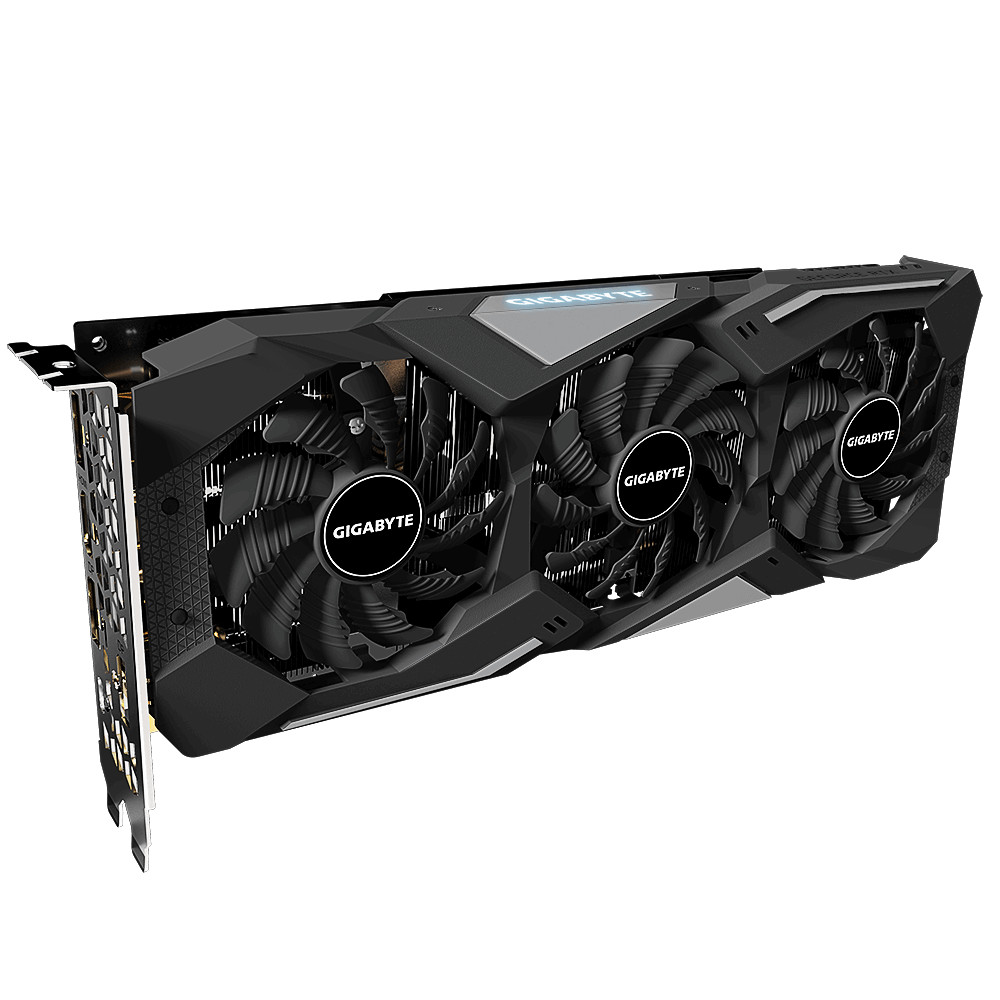
The second nomination of the rating is continued by the gaming video card manufactured by GIGABYTE. This is a two-slot device, which already clearly hints at its relative compactness. Its linear dimensions are also quite tolerable – 280x116x40 mm.
To connect the power supply to the card, two jacks are used – eight- and six-pin. It is recommended to use a power supply unit with at least 550W in the complete set of the computer. The cooling system is quite ordinary – three regular fans. The appearance of the device is unobtrusive, but pleasant to the eye.
The system is controlled by NVIDIA's GeForce RTX 2060 SUPER processor, manufactured using a thin 12nm process technology. The central chip operates at a frequency of 1815 MHz. 8192MB of video memory, type – GDDR6, frequency – 14000MHz, bus with 256bit.
In terms of reproducing images in the highest possible quality out of reasonable ones, this card is in no way inferior to all the previous ones, even the top ones. Just like all the cards described above, it supports 4 monitors (via HDMI 2.0b and three DisplayPort 1.43) and is capable of displaying a picture with a resolution of 7680×4320. Supports HDCP data security technology.
This model has the following mathematical profile: 2176 universal processors, 136 texture units, 64 rasterization units, 6.1 version of shaders. OpenGL version 4.6 and DirectX version 12 are supported, as well as CUDA version 7.5 and Vulkan. There is OpenCL version 1.2.
The peculiarity of this video card is ultra-efficient cooling. According to users' observation, in not the most demanding games, such as FIFA 19, it can work most of the time with the coolers turned off altogether.
Advantages
- performance;
- relatively compact (2 slots);
- extremely efficient cooling;
- quiet.
disadvantages
- light squeak of throttles – complaints are infrequent and not fundamental.
ASRock Radeon RX 5700 1465MHz PCI-E 4.0 8192MB 14000MHz 256 bit
Rating: 4.8
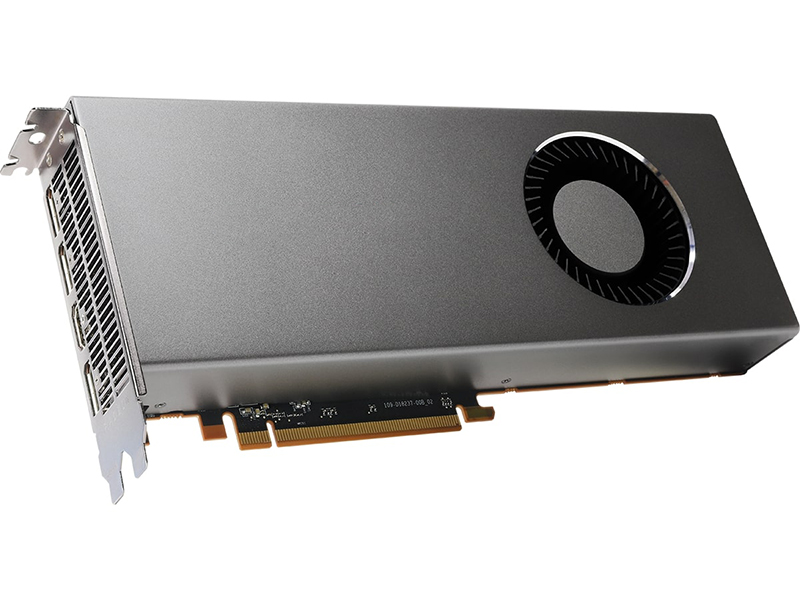
The third powerful graphics card in the 'Strong Average' category is the ASRock trademark. To some, this brand may seem unfamiliar and even suspicious, but by no means. It is “just” a subsidiary of the tech giant ASUS, which automatically clears up the question. Plus, it is also one third cheaper than the previous one, which is also important.
The exact dimensions of the device are 280.85×126.47x42mm, and here we should immediately mention the special appearance. It uses the reference design of the cooling system with one fan, and the entire card is enclosed in a solid case of the correct strict shape, due to which it looks like a candy bar. All this adds to the visual appeal of the device. The card is powered by two 8 and 6 pin sockets. It is recommended to complete the PC with a power supply unit of at least 600W. The device occupies two slots in the case.
The device is based on the original AMD Radeon RX 5700 processor, manufactured according to the most advanced 7nm process technology to date. Works at a nominal frequency of 1465MHz; in game mode – 1625 MHz, can be overclocked up to 1765 MHz. Video memory parameters – 8192MB GDDR6 with a frequency of 14GHz and a 256-bit bus.
In terms of directly demonstrated capabilities, this model completely repeats almost all the previous ones: support for 4 monitors (via HDMI 2.0b and three DisplayPort 1.43 interfaces); picture resolution up to 7680×4320; support for OpenGL version 4.6 and DirectX version 12, plus Vulkan. There is a more advanced version of OpenCL 2.0. The mathematical profile includes 2304 universal processors, 64 rasterization units, 144 texture units.
Advantages
- 7nm process technology;
- performance;
- stability and reliability;
- lends itself to overclocking;
- quite compact;
- austere attractive design.
disadvantages
- no pronounced flaws were noted.
Sapphire Pulse Radeon RX 580 1366MHz PCI-E 3.0 4096MB 7000MHz 256 bit
Rating: 4.7
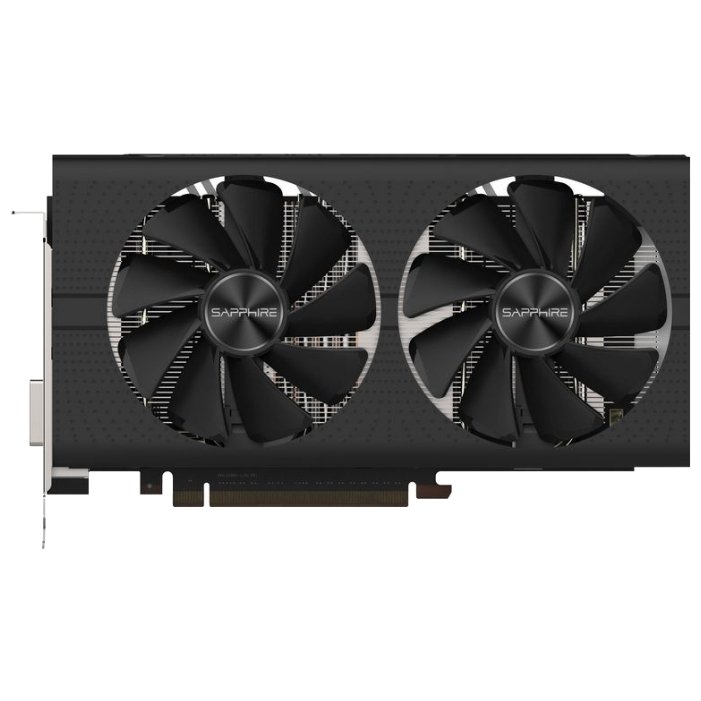
Completing the nomination of the rating of powerful video cards of the mid-price category as of September 2019 is another 'Sapphire', but only frankly budgetary. This is the most inexpensive video card in this category, which is capable of at least something in terms of gaming capabilities. It even has some 'twists'.
The first noticeable difference of this video card is its dimensions. The card is the most compact of all the previous ones – 230x125x40mm, occupies two slots, is powered by only one 8-pin socket and requires a power supply module with a capacity of at least 500W in the system unit. Cooling is provided by two fans. Connects via PCI-E 16x 3.0.
The graphics processor in this model is the Radeon RX 580 manufactured by AMD, manufactured using the 14nm process technology. Works at a frequency of 1366MHz. The installed memory is two times less than in previous inexpensive 4GB cards, and it is of a lower class – GDDR5 with a frequency of 7000 MHz, a 256-bit bus.
The 'chip' of this video card is support for as many as five monitors. Connected via two HDMI 2.0b ports, two DisplayPort 1.4 and additionally DVI-D. The image is reproduced with a resolution up to 7680×4320.
The parameters of the mathematical profile are as follows: 2304 universal processors, 144 texture units, 32 rasterization units, version 5.0 of shaders, 16x anisotropic filtering. OpenGL 4.5 and DirectX 12 are supported. Support for Vulkan, OpenCL 2.0 and AMD APP is also built in.
Advantages
- supports 5 monitors;
- compact;
- value for money;
- the most affordable price in the selection.
disadvantages
- there are instances of cooling noise and chokes under load.
The most powerful budget graphics cards
The third and final nomination for the review of powerful video cards according to the version is dedicated to the most inexpensive solutions. We analyzed the market and selected the best options, not focusing strictly on the minimum price, but still guided by your interests – so that the video card in the end was capable of at least something more than basic office work.
Sapphire Pulse Radeon RX 550 1206Mhz PCI-E 3.0 2048Mb 7000Mhz 128 bit
Rating: 4.7

And we'll start with the most powerful video card in the final nomination. This is the third 'Sapphire' in our review with a compromise performance.
It is worth noting at once the compact dimensions of the video card – only 158x112x28mm. For such dimensions, even a large, but a single fan is enough. True, according to user reviews, the video card still heats up quite noticeably under load, but not critical. It requires a computer power supply unit from 400W and has a very nice design with interesting artifacts.
The device is connected via the PCI-E8x3.0 interface. And here there are some misunderstandings – in many technical descriptions it is indicated that the card is designed for two slots, although in fact it is one-slot. One way or another, this needs to be clarified at the point of sale, since cases of confusion with the nomenclature even among the manufacturers themselves are not so rare.
At the heart of the electronics is AMD's Radeon RX 550 processor. The creators produce it using a 14nm process technology. The nominal frequency is 1206MHz. There is 2GB of GDDR5 RAM in this particular modification, but there may be more. Memory frequency – 7GHz, bus – 128-bit.
In terms of maximum resolution, this model is in no way inferior to all the previous ones – 7680×4320, but it supports fewer monitors – only three. But this, of course, is not a minus, given its cost. Interfaces: DisplayPort 1.4, HDMI 2.0b and DVI-D. Like all other models, Intel's HDCP technology is built in here against video signal removal.
Mathematical profile: 32 texture subunits, 16-degree anisotropic filtering, 16 rasterization units, 5.0 version of shaders, 512 universal processors. There is support for major standards and technologies: OpenGL 4.5, DirectX 12, Vulkan AMD APP.
Advantages
- quite compact;
- quiet;
- supports up to three monitors;
- resolution – up to 7680×4320;
- design.
disadvantages
- heats up under load.
ASUS Radeon RX 560 1149MHz PCI-E 3.0 2048MB 6000MHz 128 bit
Rating: 4.6
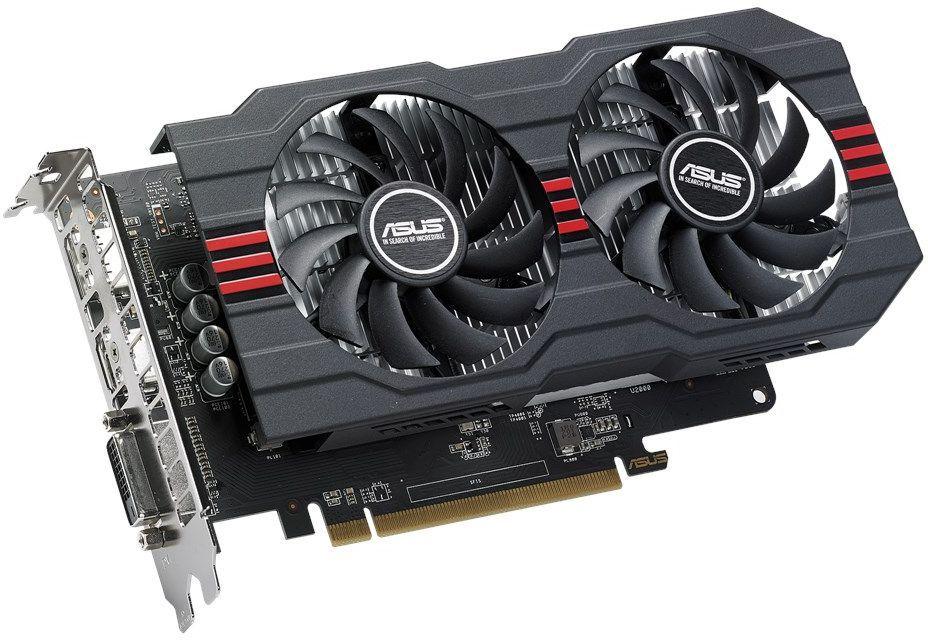
Now, in the rating of powerful video cards according to the September 2019 version, let's pay attention to another interesting model. This card is a little simpler than the above-described 'Sapphire' and even significantly cheaper.
The dimensions of the device are 220x115x39mm, it takes up two slots, cooling is provided by two coolers. For normal power supply in all modes, a power supply unit in a computer with a capacity of at least 400W is desirable. Connects via PCI-E 16x 3.0.
It has a AMD Radeon RX 560 processor with a nominal frequency of 1149MHz, manufactured using the 14nm process technology. can be overclocked to 1176MHz in game mode. The memory is installed 2GB GDDR5 with a frequency of 6000 MHz on a 128-bit bus.
In terms of direct characteristics, this is almost a complete analogue of the previous model: resolution up to 7680×4320 and support for up to three monitors via HDMI 2.0b, DVI-D and DisplayPort ports with support for secure HDCP video signal transmission.
Mathematical profile parameters: 896 universal processors, 56 texture units, 16-degree anisotropic filtering, 16 rasterization units, 5.0 version of shaders. Built-in compatibility with major standards and technologies: OpenGL 4.5, DirectX 12, Vulkan AMD APP.
Advantages
- sufficient performance;
- reliability;
- effective cooling;
- decent design.
disadvantages
- not marked.
GIGABYTE GeForce GT 1030 1252MHz PCI-E 3.0 2048MB 6008MHz 64 bit
Rating: 4.5
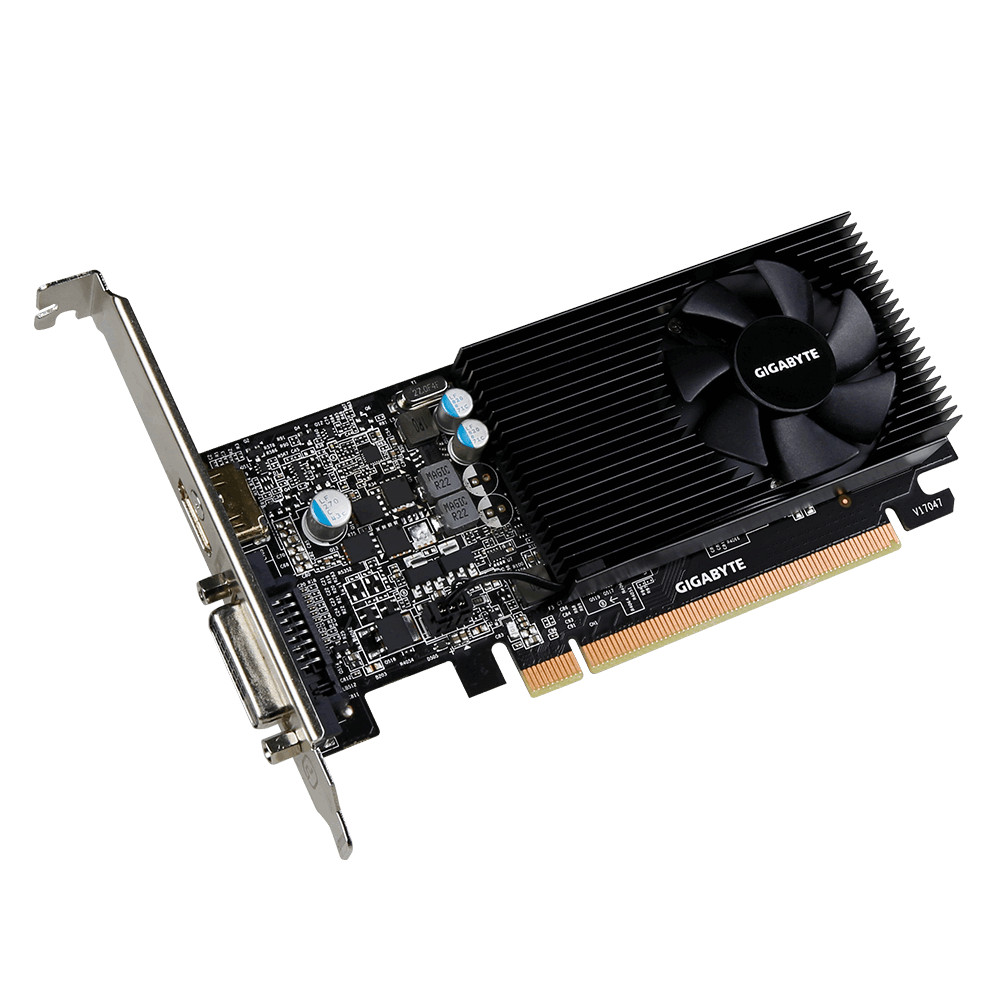
The third position in the nomination of the rating relative to budget video cards from is a representative of a large family of graphics modules manufactured by GIGABYTE. It is even significantly cheaper than the previous one, but the creators tried to keep the key characteristics as much as possible.
The dimensions of the video card are 150x69x15mm, it is designed for one slot, and, besides, it is also low-profile. Our experts specifically chose it among the equivalent options to meet the demand of users with the appropriate form factor of the system unit. The recommended power of the system unit power supply is from 300W. One fan copes with the cooling of the chip. The card is connected via the PCI-E 16x 3.0 interface.
The electronic part is represented by the NVIDIA GeForce GT 1030 processor with a frequency of 1252 MHz (overclocked to 1506 MHz). Manufactured using 14nm technology. The installed memory is 2GB, type – GDDR5 with a frequency of 6008MHz and a 64-bit bus.
The technological profile of this video card already significantly limits its capabilities when compared with previous models. So, it only supports two monitors connected via HDMI 2.0b and DVI-D with HDCP support. The maximum expansion is also limited – up to 4096×2160. But it's still a full-fledged 4K, so it's not worth complaining about this price.
The mathematical configuration is as follows: 384 universal processors, 24 texture units, 16 rasterization units, shaders version 5, anisotropic filtering – 16 times. OpenGL 4.5, DirectX 12, CUDA 6.1, Vulkan, OpenCL 1.2 are supported.
Advantages
- reliability;
- sufficient performance for most modern games at medium settings;
- minimum heating;
- quiet;
- compact;
- low profile (to whom it is important);
- quite affordable price for such parameters.
disadvantages
- not marked.
MSI GeForce GT 730
Rating: 4.4
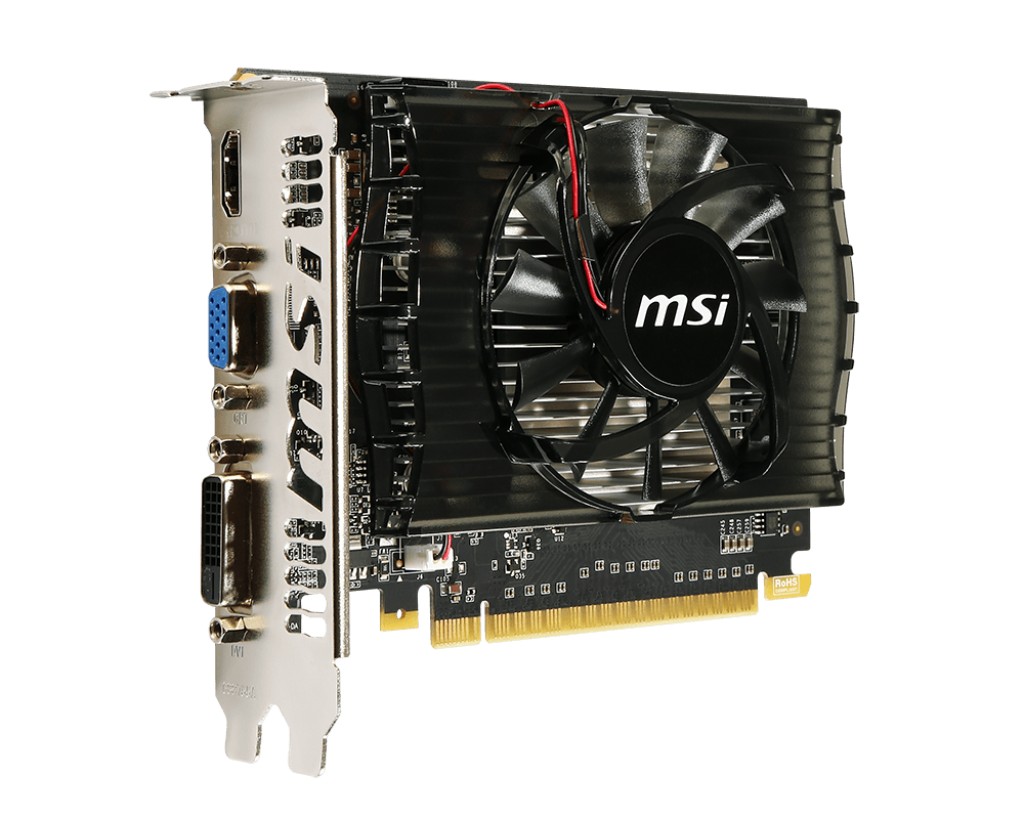
And completing the rating of powerful video cards according to the version is the most inexpensive solution from MSI in our review. This is so far the maximum that the market can offer from graphics cards comparable in characteristics, which are efficient and durable enough.
Card dimensions – 151x111x38mm, designed for two slots. Active cooling is provided by one cooler. The stock fan is quite noticeable under load, so it is often changed to a quieter one. In this case, the TDP indicator can be useful – it is 49W. The card is connected via PCI-E 16x 2.0.
The electronics of the device is based on the NVIDIA GeForce GT730 card. Manufactured using a very 'antediluvian' 40nm process technology, but, again, the price / performance ratio is on the consumer's side. Working clock frequency – 700 MHz. An unexpectedly large amount of RAM is installed, as for such a 'crumb' – 2GB. Memory type – GDDR3, frequency – 1800 MHz on a 128-bit bus.
The card supports two monitors, which can be connected via DVI-D, HDMI 1.4a or VGA connectors. Even here there is HDCP support. The maximum resolution is 4096×2160.
Mathematical profile parameters: 96 universal processors, 16 texture units, 4 rasterization units, anisotropic filtering – up to 16 times, shader version 5. The FSAA limit is 32x. The device supports OpenGL 4.4, DirectX 12, CUDA, Vulkan.
In conclusion, it is worth making a remark that this is a good video card in terms of price-performance combination, but it cannot be compared with the top monsters from the first nomination. Therefore, you should not entertain yourself with illusions and buy it at random. Before buying, you should definitely clarify whether it will be able to cope with your favorite game, and on what settings.
Advantages
- small size;
- minimum heating;
- low power consumption;
- the most affordable price in the review.
disadvantages
- noisy under load.
Attention! This rating is subjective and does not constitute an advertisement and does not serve as a purchase guide. Before buying, you need to consult with a specialist.



